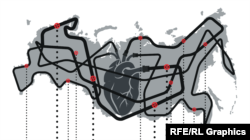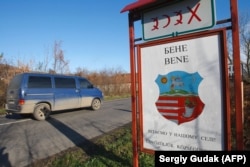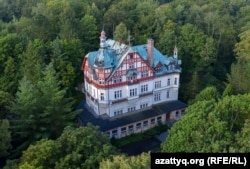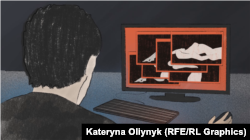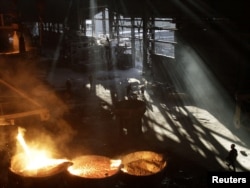There’s a problem with the remote and sprawling network of pipelines and pumping stations that helps Russia move its vast oil resources, making it the world’s second largest exporter of crude.
People are stealing the oil.
And it’s not just ordinary citizens: It’s sophisticated organized crime groups, operating under the protection of law enforcement officers, including Russia’s main security agency, the FSB, siphoning off oil using illegal taps and hoses, pumping the liquid loot from pipelines into tanker trucks or river barges.
And it’s just not just a couple of barrels.
By one estimate, from state-owned bank VTB Capital, as much as $3.5 billion is lost annually due to oil theft. Losses to the Russian budget? As much as $1.2 billion a year.
That extraordinary finding came from the exclusive work of RFE/RL’s Russian Service.
The Great Russian Oil Heist
It’s one of more than a dozen major investigations conducted this year throughout Central and Eastern Europe, Russia, the Caucasus, and South and Central Asia by RFE/RL reporters.
What European cities did politically connected insiders in Kazakhstan park their money in? Who was, in fact, behind the grisly unsolved murders of Iranian intellectuals around the world between 1988 and 1998?
Here are some of the other highlights of RFE/RL’s investigative work over the past year.
The Grisly Murder Of An Iconic Iranian Dissident
When German police entered a Bonn apartment on August 6, 1992, they found the body of a renowned Iranian entertainer, poet, and dissident who had fled his home country after the 1979 Islamic Revolution.
It was shocking enough to find a switchblade in Fereydoun Farrokhzad’s shoulder and another knife in his mouth. What was worse: the burners of the stove had been left on for days, heating the kitchen, effectively baking his decaying corpse.
A two-year investigation by RFE/RL’s Radio Farda revealed that German police thought Farrokhzad’s murder -- one of a string of killings and disappearances of Iranian dissidents around the world -- bore the hallmarks of Iranian intelligence. It remains unsolved nearly three decades on.
A former Iranian intelligence agent also claimed to Radio Farda that Iranian security services deployed another Iranian emigre, who was an acquaintance of Farrokhzad's, to commit the killing.
The findings have not only subjected the clandestine work of Iranian intelligence hit squads to new scrutiny. They have also placed renewed attention on the life of Farrokhzad, a figure who broke norms and taboos in Iranian society -- including speaking openly about his sexuality -- and who was a blistering critic of Iran's clerical regime.
From Budapest To Zakarpattya
For more than a decade, beginning in 2011, Hungarian Prime Minister Viktor Orban’s government -- and public funds allied with his political party -- has sent hundreds of millions of euros to Hungarian diaspora communities in countries across Eastern Europe: Slovakia, Romania, Croatia, Serbia, and Slovenia.
And Ukraine.
Around 150,000 ethnic Hungarians live in the western Zakarpattya region, which borders Hungary. The issue has taken on a political hue there, as some local Hungarians have chafed against government regulations on the use of languages other than Ukrainian, particularly in education.
Ukraine’s security service, meanwhile, has raided Hungarian cultural groups in the past, alleging hints of a separatist movement.
Drawing on figures first compiled by a consortium of journalism organizations in Eastern Europe, the investigative unit Schemes – run by RFE/RL's Ukrainian Service in cooperation with UA: Pershy television -- discovered that the Hungarian public fund known as Bethlen Gabor sent 115 million euros to ethnic Hungarian communities in western Ukraine.
Some of the funding appeared to be benign -- for example, renovating kindergartens where Hungarian Ukrainians can teach their children the Hungarian language and culture. Other funding has more a political tint: for example, funding billboards for an ethnic Hungarian political party that has become more nationalist in recent years.
"When such money is invested, it certainly presupposes influence and loyalty," one expert told RFE/RL.
The Big Houses, Deep Pockets Of The Kazakh Elite
Before his resignation from the presidency in 2017, Nursultan Nazarbaev was Kazakhstan’s singular leader. As the country’s first post-Soviet president, he was an unrivaled figure who presided over the Central Asian nation’s remarkable growth in prosperity -- growth fueled in no small part by its massive oil and gas reserves.
But the new prosperity came more often to political insiders and relatives of Nazarbaev, who parked their millions -- often accumulated under dubious circumstances -- in mansions and villas abroad.
Over the past two decades, relatives of Nazarbaev have purchased hundreds of millions of dollars in posh real estate in Europe and the United States: a constellation of high-end properties on luxurious lakesides, amid Manhattan’s skyscrapers, London’s tony suburbs, and overlooking the azure waters of Spain’s Costa Brava.
RFE/RL identified at least $785 million in European and U.S. real estate purchases made by Nazarbaev’s family members and their in-laws in six countries over a 20-year span.
The figure includes a handful of properties that have since been sold, including multimillion-dollar apartments in the United States bought by Nazarbaev’s brother, Bolat. It does not include a sprawling Spanish estate owned by Nazarbaev’s son-in-law Timur Kulibaev, for which a purchase price could not be found.
The findings offer an unprecedented window into the scale of the real estate investments by Nazarbaev’s relatives, and how many in close proximity to Kazakhstan’s ruling family ended up with luxury assets in exclusive locations.
“It is hard to separate the government from the [Nazarbaev] family,” a longtime Kazakh rights expert told RFE/RL.
Blackmail, Rape, Suicide In Central Asia
The global webcam industry -- where clients from all over the world pay people, women or men, to chat, undress, and often perform sexual acts on camera -- generates billions of dollars annually.
In Central Asia, the Kyrgyz capital, Bishkek, and neighboring Kazakhstan’s economic capital, Almaty, have emerged as regional hubs for webcam studios.
In Kyrgyzstan, as many as 5,000 young women are believed to be working as so-called “webcam models,” many of whom are trying to make ends meet in a country where nearly a third of the population lives in poverty.
An investigation by RFE/RL’s Kyrgyz Service explored how many of those women are essentially lured into a kind of modern-day slavery and face abuse, blackmail, and, in some cases, rape.
Many of the women are afraid to go to the police, fearing they could be exploited or extorted for money.
"There are so many young women whose parents are sick, who have disabled children. They really need the money," said one woman who has since stopped working in the webcam industry.
Manganese Mayhem In Georgia
It’s one of Georgia’s largest industrial operations: a massive manganese mine in a western district that, according to activists and nearby residents, has been causing large-scale pollution and environmental damage for years.
The Georgian Manganese LLC ore mine in the town of Chiatura also happens to be controlled by a business group closely linked to the political party Georgian Dream, which has dominated the country’s politics since 2012.
With previous ownership tracing back to a shadowy U.S. corporation owned by a Ukrainian billionaire, Georgian Manganese LLC has in recent years been fined hundreds of millions of dollars in penalties by regulators -- fines that have been mysteriously reduced.
The company has been the subject of numerous allegations of labor violations.
RFE/RL’s Georgian Service spent months digging through corporate registries, ownership records, and regulatory filings to show how the Georgian Dream-linked business group schemed to take control of the mine while also flouting environmental regulations – to the detriment of nearby villagers.
The Uzbek President's Secret Mountain Hideaway
Exactly a month after he was sworn in as Uzbekistan’s second leader since the fall of the Soviet Union in 1991, President Shavkat Mirziyoev delivered a speech to a joint session of parliament.
His January 2017 address touched on numerous issues, not the least of which was fiscal responsibility.
Within weeks of the speech, however, Uzbek state-owned companies embarked on a secretive project that raised serious questions about Mirziyoev’s sincerity: an exclusive, remote mountain compound, including a new reservoir, that was built for Mirziyoev’s use.
The recreation complex was uncovered as part of a multipart investigation by RFE/RL’s Uzbek Service, which spoke with numerous sources directly involved or aware of the opaquely financed project located on a protected biosphere reserve and sealed off from the public by roadblocks and security personnel.
Two sources estimated the cost of the development at several hundred million dollars, though only a handful of publicly available official documents even make reference to the compound and the adjacent reservoir, which were largely completed by 2019.
The investigation also revealed some of the project’s human cost, including water disruptions suffered by villagers downstream and the displacement of a family known for its stewardship of the area’s ecosystem.
